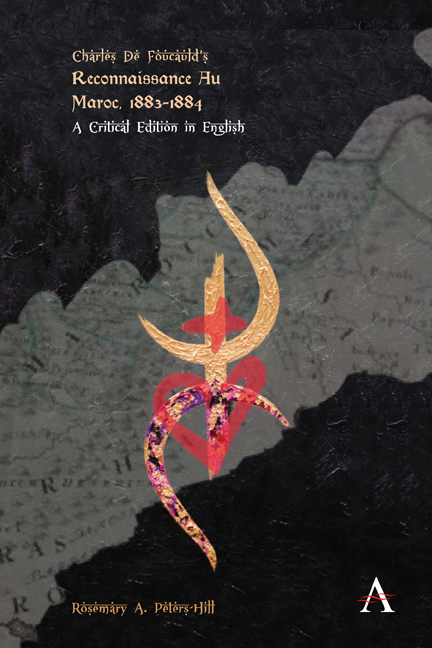Book contents
- Frontmatter
- Contents
- List of Figures
- Acknowledgments
- “There are no roads”: Charles de Foucauld’s Reconnaissance au Maroc—a Critical Introduction
- Charles de Foucauld, Reconnaissance au Maroc, 1883–1884
- Letter to François de Bondy
- Introduction
- Avant-Propos
- I Tangiers to Meknès
- II Meknès to Qaçba Beni Mellal
- III Qaçba Beni Mellal to Tikirt
- IV Tikirt to Tissint
- V Sojourn in the Sahara
- VI Tissint to Mogador
- VII Mogador to Tissint
- VIII Tissint to the Dadès
- IX The Dadès to Qçabi ech Cheurfa
- X Qçabi ech Chorfa to Lalla Maghnia
- Appendix: The Jews of Morocco
- Note on the Materials Used to Draw Up My Itinerary
- Report Delivered to the Société de Géographie de Paris in Its General Session of 24 April 1885
- “Itineraries in Morocco”
- Afterwards: An Afterword
- Glossary of Terms
- Bibliography
- Index
VII - Mogador to Tissint
Published online by Cambridge University Press: 20 January 2022
- Frontmatter
- Contents
- List of Figures
- Acknowledgments
- “There are no roads”: Charles de Foucauld’s Reconnaissance au Maroc—a Critical Introduction
- Charles de Foucauld, Reconnaissance au Maroc, 1883–1884
- Letter to François de Bondy
- Introduction
- Avant-Propos
- I Tangiers to Meknès
- II Meknès to Qaçba Beni Mellal
- III Qaçba Beni Mellal to Tikirt
- IV Tikirt to Tissint
- V Sojourn in the Sahara
- VI Tissint to Mogador
- VII Mogador to Tissint
- VIII Tissint to the Dadès
- IX The Dadès to Qçabi ech Cheurfa
- X Qçabi ech Chorfa to Lalla Maghnia
- Appendix: The Jews of Morocco
- Note on the Materials Used to Draw Up My Itinerary
- Report Delivered to the Société de Géographie de Paris in Its General Session of 24 April 1885
- “Itineraries in Morocco”
- Afterwards: An Afterword
- Glossary of Terms
- Bibliography
- Index
Summary
Mogador to Douar Oumbarek ou Dehen
Mogador, whose name is written in large letters on our maps, is far from the significant port we could imagine it to be. The person who would expect to find a city in constant contact with Europe would be disappointed. Especially in winter, the means of communicating are rare and irregular. Only after 45 days did I receive from Paris a response to letters sent the day after my arrival here. This state of things is linked to the fact that Mogador does little trade today: the port no longer does business except with the Chiadma, Haha, Chtouka, and Ilalen tribes, plus the Sahel and Tindouf, and through there, Timbucktu. It has the monopoly on most trade from the Sudan, conducted by the Tajakant. That is the best privilege Mogador has retained. As for the Souss basin, as well as western and central Sahara, from the Oued Aqqa to the Oued Ziz, they make their purchases in Marrakesh, and that capital receives everything from Djedida (Mazagan). The big commercial center of Morocco is Marrakesh: south of the Atlas, Fez provides the flow of the Oued Ziz and the Sahara region to the east of that river; Mogador supplies the Sahel and the small section of the Drâa basin located to the west of the Oued Aqqa. Marrakesh provides for the entire Souss basin, the huge Drâa basin (except for the small reserve we have just done), all the way to those districts irrigated by the right-side tributaries of the Ziz, such as the Todgha and the Ferkla.
As soon as I received the letters I was waiting for from France, I got underway to the south to get back to Tissint. My friend the Hajji had waited for me: this time I traveled alone with him; he had sent his companion home.
14 to 20 March 1884. Leaving Mogador on 14 March, with the son of S. Abd Allah d Aït Iahia, whose father had given him to us as escort, we arrived at the religious residence of the Ksima tribe on the 20th of the same month. Torrential rains that fell for part of this time had hampered our progress; this is why we took seven days to cover a distance that usually only requires four.
- Type
- Chapter
- Information
- Charles de Foucauld’s Reconnaissance au Maroc, 1883–1884A Critical Edition in English, pp. 305 - 316Publisher: Anthem PressPrint publication year: 2020



